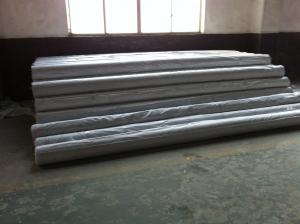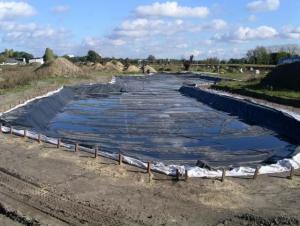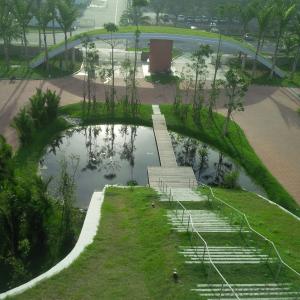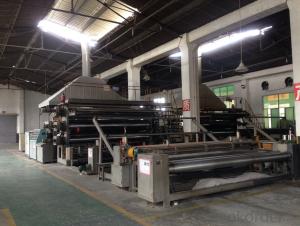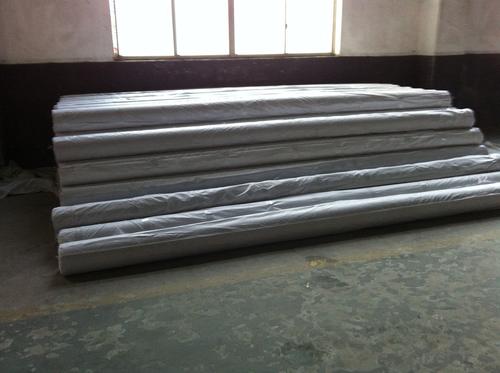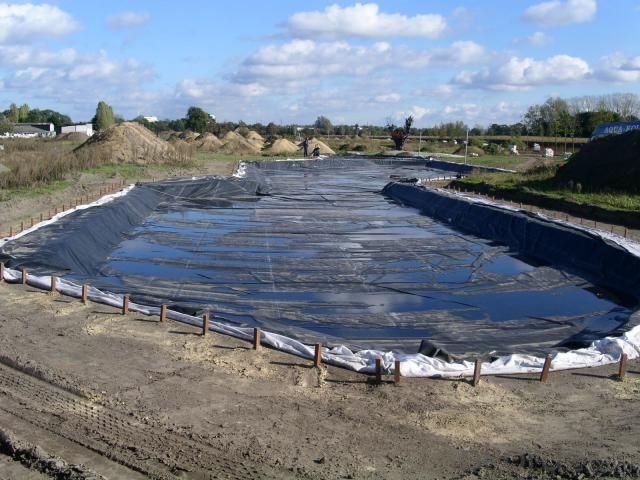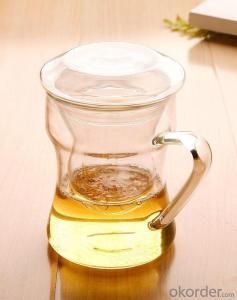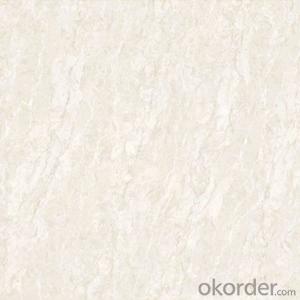Pond liner excellent manufacturer 2015 HOT
- Loading Port:
- Qingdao
- Payment Terms:
- TT OR LC
- Min Order Qty:
- 1000 m²
- Supply Capability:
- 1000000 m²/month
OKorder Service Pledge
OKorder Financial Service
You Might Also Like
1. Introduction
| EPDM waterproof membrane is made from ternary ethylene-propylene
rubber, which is for waterproofing of exposed and non-exposed applications.
| EPDM waterproof membrane production adopts the world-advanced equipment of
cold feeding extrusion and continuous vulcanization technology.
| EPDM waterproof membrane is of high elasticity among high polymer waterproof materials
and becomes a world-popular waterproofing material.
2. Specification
1) Material: EPDM Rubber
2) Size: 1.2m/2m/3m/4m (width)*20m (length) or customized,
3) Thick: 1.2mm, 1.5mm, 2.0mm
4) Type: Weldable
5) Pattern: Non-reinforced (homogeneous)
6) Certificate: ISO9001/14001
3. Features
| Excellent physical and mechanical performance
| High tearing resistance
| Good deformation adaptability
| High puncture resistance
| High aging resistance
4. Applications
l Roofs, Basement, Toilets
l Industrial and civil building waterproofing
l Geosynthetic liner for swimming pool, channels, irrigation system
l Especially suitable for projects with high requirements in durability, anti-corrosion and
deformation.
- Q: Can a waterproofing membrane be used in areas with extreme weather conditions?
- Yes, a waterproofing membrane can be used in areas with extreme weather conditions. Waterproofing membranes are designed to provide protection against water intrusion and can withstand a wide range of weather conditions, including extreme heat, cold, heavy rainfall, and snow. These membranes are made from durable materials that are resistant to UV rays, temperature fluctuations, and other environmental factors. Additionally, some waterproofing membranes are specifically designed for use in areas with extreme weather conditions, offering enhanced performance and durability. It is important to choose a waterproofing membrane that is suitable for the specific weather conditions of the area to ensure long-lasting and effective protection.
- Q: Can a waterproofing membrane be used for exterior foundation walls?
- Yes, a waterproofing membrane can be used for exterior foundation walls. Waterproofing membranes are designed to provide a protective barrier against water infiltration, and they are commonly used in construction to prevent moisture from entering below-grade structures such as foundation walls. These membranes are typically made of durable materials like rubber, asphalt, or polymer-based compounds that are resistant to water penetration. By installing a waterproofing membrane on the exterior side of foundation walls, it creates a barrier that prevents water from seeping into the foundation, which can help to prevent issues such as water damage, mold growth, and structural deterioration. Additionally, waterproofing membranes can also help to reduce the potential for cracks and leaks in the foundation, enhancing the overall durability and longevity of the structure.
- Q: Are there any drawbacks or limitations to using a waterproofing membrane?
- Yes, there are some drawbacks and limitations to using a waterproofing membrane. One limitation is that the installation process can be time-consuming and labor-intensive. Waterproofing membranes often require careful surface preparation and multiple layers, which can be time-consuming and may require skilled labor. This can increase the overall cost of the project. Another limitation is that waterproofing membranes may not be suitable for all surfaces. Some membranes are designed specifically for certain types of substrates, such as concrete or metal, and may not adhere properly to other materials. It is important to select the appropriate type of membrane for the specific surface to ensure proper adhesion and effectiveness. Additionally, waterproofing membranes can be sensitive to environmental conditions. Extreme temperature fluctuations, UV exposure, and chemical exposure can degrade the membrane over time, reducing its effectiveness. Regular inspections and maintenance may be required to ensure the longevity of the membrane. Furthermore, waterproofing membranes can be susceptible to damage during installation or from external factors such as foot traffic or heavy objects. Punctures, tears, or improper installation can compromise the integrity of the membrane and reduce its ability to prevent water infiltration. Lastly, waterproofing membranes may not completely prevent water penetration in certain situations. For example, if there are existing cracks or structural issues in the substrate, water may still find a way to seep through, bypassing the membrane. It is important to address any underlying structural issues before applying the membrane to ensure optimal performance. Overall, while waterproofing membranes offer many benefits in terms of protecting against water damage, it is crucial to consider these limitations and drawbacks to make an informed decision about their use in specific applications.
- Q: Can a waterproofing membrane be used in commercial construction?
- Certainly, a waterproofing membrane is a viable option for utilization in commercial construction. In actuality, it serves as an essential element throughout the construction process. Its purpose is to establish a barrier against moisture, effectively preventing water infiltration and safeguarding the structure from potential water-related harm. This element proves particularly crucial in commercial edifices, where water poses a significant threat to the structural integrity. It can lead to severe problems, including mold proliferation, material deterioration, and even compromise the foundation's stability. Waterproofing membranes find widespread application in various areas of commercial construction, encompassing basements, roofs, foundations, and even external walls. They come in diverse forms, such as sheets, liquid coatings, or spray-applied membranes, allowing for flexibility and adaptability in different construction scenarios. All in all, incorporating a waterproofing membrane in commercial construction endeavors is a prudent investment, ensuring the long-lasting endurance and efficiency of the building.
- Q: Can waterproofing membranes be used on outdoor patios?
- Yes, waterproofing membranes can be used on outdoor patios. They are an effective way to protect the patio from water damage and can help to prevent leaks and moisture penetration. Waterproofing membranes create a barrier between the patio surface and water, keeping it dry and extending its lifespan.
- Q: Can a waterproofing membrane be used on balconies or decks?
- Yes, a waterproofing membrane can be used on balconies or decks. Waterproofing membranes are designed to provide a protective barrier against water and moisture, making them an ideal solution for outdoor spaces that are constantly exposed to the elements. These membranes are typically made of materials such as rubber, PVC, or bitumen, and are applied directly to the surface of the balcony or deck. They are designed to prevent water from seeping into the underlying structure, protecting it from potential damage caused by moisture. Waterproofing membranes are especially beneficial in areas where heavy rainfall, snow, or high humidity are common, as they help to extend the lifespan of the balcony or deck by preventing water-related issues such as rot, mold, or deterioration. Additionally, these membranes can also provide an added layer of protection against UV rays, preventing discoloration or fading of the balcony or deck surface. Overall, using a waterproofing membrane on balconies or decks is a smart investment to ensure their longevity and maintain their aesthetic appearance.
- Q: How does a waterproofing membrane handle exposure to chemicals?
- Different types of waterproofing membranes have varying levels of resistance to chemicals. Some membranes are specifically designed to withstand exposure to chemicals, while others may not be as resistant. Typically, a waterproofing membrane that is specifically formulated to handle chemicals will have certain properties that make it more resistant. These properties may include a thicker material, increased flexibility, and additives that enhance chemical resistance. When a waterproofing membrane is exposed to chemicals, it should ideally be able to resist degradation, maintain its physical properties, and continue to effectively repel water. However, it is important to consider that certain chemicals may still have a negative effect on the membrane, especially if they are highly corrosive or reactive. To ensure the best performance when dealing with chemical exposure, it is recommended to choose a waterproofing membrane that is specifically designed to handle the types of chemicals it will encounter. It is also important to follow the manufacturer's guidelines for installation and maintenance to maximize the membrane's chemical resistance and overall lifespan. Regular inspections and maintenance are essential for identifying any signs of chemical damage or degradation on the waterproofing membrane. In cases where significant chemical exposure is expected, additional protective measures such as chemical-resistant coatings or overlays may be necessary to provide an extra layer of defense. In conclusion, the ability of a waterproofing membrane to withstand exposure to chemicals depends on its specific formulation and design. By selecting a membrane with appropriate chemical resistance properties and practicing proper maintenance, its longevity and effectiveness in chemical environments can be ensured.
- Q: Are waterproofing membranes resistant to thermal expansion?
- Yes, waterproofing membranes are typically resistant to thermal expansion. They are designed to withstand temperature changes without undergoing significant dimensional changes, ensuring their effectiveness in preventing water penetration and maintaining their integrity.
- Q: Does a waterproofing membrane require any special considerations for installation in earthquake-prone areas?
- Yes, a waterproofing membrane does require special considerations for installation in earthquake-prone areas. In these areas, the ground is more susceptible to movement and shaking, which can significantly impact the integrity of the waterproofing system. Therefore, it becomes crucial to take additional precautions to ensure that the membrane is properly installed and capable of withstanding seismic activity. One important consideration is the selection of the waterproofing membrane itself. It is recommended to choose a membrane that has been specifically designed and tested to withstand seismic activity. These membranes are usually more flexible and have higher tensile strength to accommodate ground movement during earthquakes. Additionally, the installation process should be executed with utmost care and attention to detail. The membrane should be properly anchored or secured to the substrate using appropriate fasteners and adhesives. Reinforcement techniques such as the use of reinforcing fabric or mesh can also be employed to enhance the membrane's resistance to movement. Furthermore, it is essential to ensure that all seams and joints in the membrane are properly sealed and reinforced. Special attention should be given to areas that are more prone to movement, such as corners, edges, and penetrations. Using compatible and high-quality sealants or adhesives will help maintain the integrity of these vulnerable points. Regular inspections and maintenance are also crucial in earthquake-prone areas. Inspecting the membrane periodically for any signs of damage, such as cracks or separations, allows for early detection and timely repairs. Additionally, it is vital to have a contingency plan in place to address any potential damage that may occur during an earthquake, including emergency repair procedures. In summary, installing a waterproofing membrane in earthquake-prone areas requires careful consideration and adherence to specific guidelines. By selecting an appropriate membrane, properly anchoring and reinforcing it, ensuring proper sealing of seams and joints, and conducting regular inspections, the waterproofing system can be better prepared to withstand earthquakes and provide long-lasting protection against water intrusion.
- Q: Are waterproofing membranes resistant to high temperatures?
- Yes, waterproofing membranes are typically designed to be resistant to high temperatures. They are made from materials such as modified bitumen, PVC, or EPDM that have excellent heat resistance properties, allowing them to withstand high temperatures without degrading or losing their waterproofing capabilities.
Send your message to us
Pond liner excellent manufacturer 2015 HOT
- Loading Port:
- Qingdao
- Payment Terms:
- TT OR LC
- Min Order Qty:
- 1000 m²
- Supply Capability:
- 1000000 m²/month
OKorder Service Pledge
OKorder Financial Service
Similar products
Hot products
Hot Searches
Related keywords
